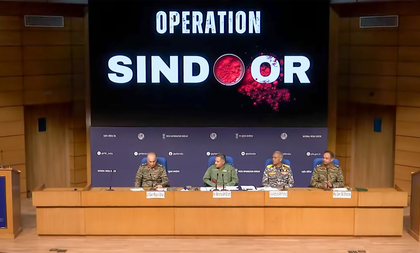Multi-layered counter-drone, air defence grid shield foiled Pak air attacks: DGMO
By IANS | Updated: May 12, 2025 15:27 IST2025-05-12T15:23:38+5:302025-05-12T15:27:38+5:30
New Delhi, May 12 The budgetary and policy support provided by the government to the forces over the ...

Multi-layered counter-drone, air defence grid shield foiled Pak air attacks: DGMO
New Delhi, May 12 The budgetary and policy support provided by the government to the forces over the past decade helped build an impregnable air defence shield that helped repulse attacks by Pakistani forces, which was exhibited during India’s anti-terror 'Operation Sindoor', said the Director General of Military Operations (DGMO) in a press briefing on Monday.
All airbases and military bases are operational and ready for their next missions, said Air Marshal A.K. Bharti, dismissing misinformation attempts.
“Our fight is with the terrorists and not with Pakistani military or civilians,” he said.
Director General of Military Operations Rajiv Ghai said the multi-layered counter-drone and air defence grid proved to be the decisive shield that foiled all Pakistan air attacks on the night of May 9 and 10.
The officials said during Operation Sindoor, the defence systems destroyed Chinese and Turkish-made drones and PL-15 missiles, preventing them from entering our airspace.
Sharing videos of a crater created by Indian bombs and missiles at Pakistan’s Noor Khan airbase, Ghai said Indian airfields remain fully operational.
“I want to praise the Border Security Force also, who complemented our efforts by joining our counter-armed response,” he said.
“There has been absolute synergy in the three services, and not only have we been supported by government agencies, but also the 140 crore people,” he said.
“Our fight was against terror, and on May 7, we hit only terror hubs, but the Pakistani Army converted it into its own fight by supporting terrorists,” said Air Marshal Bharti.
He described the multi-layered and integrated air defence (AD) as an impregnable shield which foiled all attempts made by Pakistani forces, including Unmanned Combat Aerial Vehicles, to violate Indian airspace.
The performances of the older battle-proven systems were stellar, in addition to the Akash system, he said.
Vice Admiral A.N. Pramod highlighted the Indian Navy’s pressure that deterred the Pakistani Navy and Air Force to keep away from Arabian Sea.
Earlier in the day, Prime Minister Narendra Modi chaired a high-level meeting with top government functionaries, including Defence Minister Rajnath Singh, External Affairs Minister S. Jaishankar, and NSA Ajit Doval.
The meeting took place at the Prime Minister’s residence in the national capital. Defence Minister Rajnath Singh, Chief of Defence Staff General Anil Chauhan and all three service chiefs - General Upendra Dwivedi, Admiral Dinesh K. Tripathi and Air Chief Marshal Amar Preet Singh - attended the meeting.
Foreign Secretary Vikram Misri, Intelligence Bureau (IB) Director Tapan Deka, and Research and Analysis Wing (R&AW) chief Ravi Sinha were also in the meeting.
The high-level meeting came two days after India and Pakistan arrived at an understanding for a ceasefire with a decision that the DGMOs of both sides would talk to each other on May 12. The ceasefire was sought by Pakistan after facing massive airstrikes by the Indian Air Force that destroyed 11 of its airbases.
Disclaimer: This post has been auto-published from an agency feed without any modifications to the text and has not been reviewed by an editor
Open in app